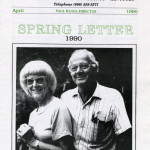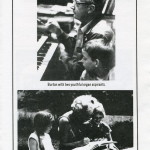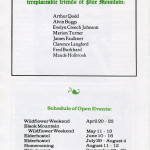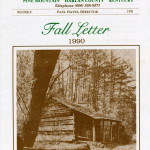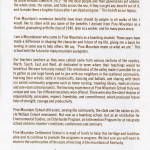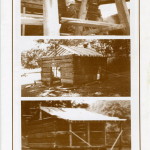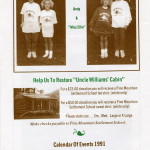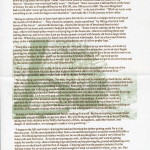Pine Mountain Settlement School
Series 17: PUBLICATIONS PMSS
Notes 1990
April and Novmber
NOTES – 1990
“Notes from the Pine Mountain Settlement School”
Spring (April) and Fall (November) Letters,1990
GALLERY: NOTES – 1990 Spring Letter (April)
…[W]e feel a special desire to use this letter to honor the devotion of two long-time workers, Mary and Burton Rogers, whose energy, talents, and love have [benefited] Pine Mountain since 1942.
- NOTES – 1990 April, page 1. [PMSS_notes_1990_april_0011.jpg
- NOTES – 1990 April, page 2. [PMSS_notes_1990_april_0021.jpg
- NOTES – 1990 April, page 3. [PMSS_notes_1990_april_0031.jpg
- NOTES – 1990 April, page 4. [PMSS_notes_1990_april_0041.jpg]
TAGS: NOTES – 1990 April, photographs, Mary Rogers, Burton Rogers, organ, reading, golden wedding anniversary, in remembrance
TRANSCRIPTION: NOTES – 1990 April
P. 1
PINE MOUNTAIN
SETTLEMENT SCHOOL
PINE MOUNTAIN HARLAN COUNTY KENTUCKY 40810
Telephone: (606) 558-3571
April PAUL HAYES, DIRECTOR 1990
SPRING LETTER
1990
[Featured photograph] “Mary and Burton Rogers
Devoted Workers since 1942″
P. 2
Spring, 1990
Dear Friend of Pine Mountain,
Since 1913, when Pine Mountain Settlement School began, its story of creative, unique responses to the needs of “its” valley has been told in a series of Pine Mountain letters and notes. The School’s devotion to bringing the best to that valley, its children, and its extended, inter-connected area, shines through those letters, which have communicated the aspirations, challenges, needs and successes of Pine Mountain Settlement School.
Most of those letters have concentrated on the activities, ideas, and requirements of the School at a particular time. The names of our founders — Uncle William and Aunt Sal Creech, Miss Katherine Pettit and Mrs. Ethel de Long Zande — have appeared among the recountings of hopes, achievement and plans. Pride and appreciation for many students and workers have been genuinely expressed, but usually without specific names. So it has continued: the urgency of telling you about our building repair, spring plantings, vital programs, and continuing income/expense problems could easily fill our letter space.
However, we feel a special desire to use this letter to honor the devotion of two long-time workers, Mary and Burton Rogers, whose energy, talents, and love have benefitted Pine Mountain since 1942. Acknowledging their myriad gifts to Pine Mountain — including Burton’s patient wisdom as counselor, teacher, director, gardener, letter-writer, organist, and weather expert, and Mary’s inspiring ingenuity as housemother, teacher, librarian, storyteller, artist, archivist, hostess, environmental educator and Nativity Play director — is a process which can only be completed by each person priviledged (sic) to have experienced their friendly interest. We are pleased to take this opportunity to salute them, thank them, and wish them a beautiful Golden Wedding anniversary this summer.
We also thank each of you for your faithful interest and support.
In the spirit of Pine Mountain,
[Signed] Paul
Paul Hayes, Director
Pine Mountain Settlement School
P. 3
[Photograph] “Burton with two youthful organ aspirants.”
[Photograph] “Reading is inspired early by Mary.”
P. 4
In Remembrance of,
irreplaceable friends of Pine Mountain:
Arthur Dodd
Alvin Boggs
Evelyn Creech Johnson
Marion Turner
James Faulkner
Clarence Langford
Fred Burkhard
Maude Holbrook
*
Schedule of Open Events:
Wildflower Weekend April 20-22
Black Mountain Wildflower Weekend May 11-13
Elderhostel June 10-16
Elderhostel July 29-August 4
Homecoming August 11-12
Elderhostel September 23-29
Fall Color Weekend October 19-21
Elderhostel November 4 – 10
Nativity Play December 16
GALLERY: NOTES – 1990 Fall Letter (November)
Pine Mountain School still exists…not now as a boarding school, but as an institution for Environmental Studies, an Elderhostel Program, an Intervention Program for at risk grade school children, [teachers’] institutes, conferences and seminars.
- NOTES – 1990 Nov., page 1. [PMSS_notes_1990_nov_0011.jpg]
- NOTES – 1990 Nov., page 2. [PMSS_notes_1990_nov_0021.jpg]
- NOTES – 1990 Nov., page 3. [PMSS_notes_1990_nov_0031.jpg]
- NOTES – 1990 Nov., page 4. [PMSS_notes_1990_nov_0041.jpg]
- NOTES – 1990 Nov., page 5. [PMSS_notes_1990_nov_0051.jpg]
TAGS: NOTES – 1990 November, Cabin, photographs, relocation, William Creech, past and present, tee shirts
[insert] Cabin history, Environmental Education
TRANSCRIPTION: NOTES – 1990 November
P. 1
PINE MOUNTAIN
SETTLEMENT SCHOOL
PINE MOUNTAIN HARLAN COUNTY KENTUCKY
Telephone: (606) 558-3571
NOVEMBER PAUL HAYES, DIRECTOR 1990
FALL LETTER
1990
[Photograph] “Uncle William’s Cabin originally built
and occupied, March, 1871“
P. 2
Fall, 1990
Dear Friends:
Nestled in a secluded valley surrounded by mountains, whose glorious colors change with the season, is located Pine Mountain Settlement School. Land was deeded for the school by Uncle William Creech in 1912 “for the local people and their generations yet unborn, the whole state, the nation, and folks across the sea, if they can get any benefit out of it, and to make them a brighter future after I am dead and gone.” This he left as our legacy.
Pine Mountain’s numerous benefits have been shared by people in all walks of life. I would like to share with you some of the benefits I derived from Pine Mountain as a student, graduating with the class of 1940, later as a worker, and for many years since.
I am a Mountaineer who came to Pine Mountain as a boarding student. Those years have made a difference in shaping the character and future of my life, giving me a basis for serving in some way to help others. We say, “Pine Mountain made us what we are.” This school held the future for many mountain youngsters.
Our teachers (workers as they were called) came from various sections of the country, North, South, East and West, all dedicated to serve where their teachings would be [beneficial]. We were fortunate indeed! The remoteness of the valley made it possible for us to gather as one large family and to join with our neighbors in the scattered community, learning their artistic skills in handicrafts, dancing and ballads, and sharing with them our varied community programs such as home nursing, traveling library, medical clinics, and one-room school projects. The learning experience at Pine Mountain School truly was unique and rare. Ten different vocations were offered. There were also the silent lessons of responsibility, principles, respect, friendship, and [commitment], which produced future lives of strength, courage and productivity.
Pine Mountain School still exists, serving the community, the state and the nation as Uncle William Creech envisioned. Not now as a boarding school, but as an institution for Environmental Studies, an Elderhostel Program, an Intervention Program for at risk grade school children, teacher’s institutes, conferences and seminars.
Pine Mountain Settlement School is in need of funds to keep this heritage and tradition alive and to continue to promote the programs in progress. We feel sure you will want to share in the continuation of this oasis of learning in the mountains of Kentucky.
[Signed]
Ruth Shuler Dieter
Abilene, Kansas
P. 3
[Three photographs] The above photos show the second relocation of
Uncle William’s Cabin on the school’s campus
P. 4
[Two photographs of a boy and girl standing together.]
Andy
&
“Miss Ellie”
Help Us To Restore “Uncle Williams’ Cabin”
[Small photograph of the cabin.]
For a $25.00 donation you will receive a Pine Mountain. Settlement School tee shirt. (white only)
For a $50.00 donation you will receive a Pine Mountain Settlement School sweat shirt. (white only)
Please state size . . . Sm., Med., Large or X-Large.
Make checks payable to Pine Mountain Settlement School.
*
Calendar Of Events 1991
Wildflower Weekend April 19 – 21
Elderhostel June 9 – 15
Elderhostel July 28 – August 3
Homecoming August 10
Elderhostel September 22 – 28
Fall Color Weekend October 18 – 20
Elderhostel November 10 – 16
Nativity Play December 15
P. 5
WHAT IS KNOWN ABOUT UNCLE WILLIAM’S CABIN
William Creech was born in August in Poor Fork, Kentucky (now Cumberland). When he was 19, he joined the Union army. He was discharged the following year, married Sally Dixon in March 1886, and settled down in a log house on his father’s land. After three years he found he could not make a living there as “the place was small and badly worn”. He heard “there was some wild land here on the head of Greasy for sale so I bought 600 acres for $50.00, also 100 acres for $90. The next thing that I had to look after was to get my new home back in the woods” so he and a brother “filled our sacks with something to eat, took our bags on our shoulders” and made the 13 mile journey to this valley. “Being in a dense thicket of laurel and spruce pine (hemlock) we started a campground at a spring at the mouth of Till Hollow”. They cleared a campsite, made a good bed “by filling a bed tick with leaves of the forest”, and cut the house logs, cleared the house site of brush and then invited neighbors from home and around to help put up the house. “Some went to cutting out the way to the logs, others with hand spikes went to carrying logs to the house site, others to notching them and putting them up, and in two days I got my house up and covered with boards slit from a large white oak tree. When this was done my hands was all dismissed with thanks. So I cut a door and chimney place in the wall and laid my floor by splitting puncheons out of yellow poplar logs.”
“When this was done the next thing was to get my wife and children to my new home, so I took my journey back after them. By this time our family had increased two in number; so we at once began packing our plunder. Finding we had accumulated enough that we had to have horse stock to move on, I got two of brother-in-laws and three horses on the 23rd day of March 1871 we took up our journey to our new home in the back woods, and it was almost sunset when we got to our new home and by this time it had turned very cold and disagreeable.”
“We at once kindled a fire in the chimney place and nailed boards to keep the cold wind out of the house. All of this took till a late hour that night so we took a short rest on the puncheon floor.” (Aunt Sal reports they had brought three mighty skimpy feather beds.)
“Next morning our trouble began. Our baby began to cry and said he wanted to go back home, and my wife almost broke down and said that she would rather go back to Poor Fork and live on bread and water than to stay here and have everthing in the world. Knowing we was in such a situation that we could not leave here, my wife being a resolute little woman said she would try and stay. So it was a trying proposition on her for I had to find some land I could rent and make some corn on and by going away to rent land, I left my wife and our two little children all alone except at night. And she would tell me that she would sit and study and get afraid of the Indians. It would be weeks at a time that she would not see anyone pass by our house and she had raised up on a farm in very thickly settled country…and now she did not have anything to do but her washing and her waiting on her little children and cooking what little we had to eat which made it much harder for her.”
“In June we had a baby girl added to our family making five in all. By the next spring we could plant some corn and garden truck on our new place. My wife being as good at farm work as myself and by taking our little children in the field to be the prey of flies, mosquitoes, and other insects, and danger of rattlesnakes, we managed to make a very good crop..”
“I began in the fall and winter clearing the land and burning the timber getting ready for a crop the next year. All the merchantable timber I have cut and burned I guess would be worth $50,000 or more. Not thinking that such timber would ever be worth anything here, I used it very liberal for fence rails and firewood… So early next spring my wife, children and myself went to getting ready for another crop, then to burning logs and brush and me plowing the ground and planting corn which we worked hard until the first of August. Clearing land was the greatest industry for the fall and winter for several years until we had enough for what we needed for wheat, corn, rye, flax and buckwheat. In the dry season of the year we had to grind our meal on a hand mill which was very hard work.”
“By raising flax and sheep, my wife carded and spun and wove cloth to make clothes for us all while I tanned leather to make all the shoes we owned and wore, and worked in my blacksmith shop. When the children got large enough to do work, the boys helped me and girls helped their mother…”
Previous:
NOTES – 1989
Next:
NOTES – 1991
See Also:
Aunt Sal’s CABIN
HISTORY PMSS Summary 1989-1990 (Missing)
HISTORY PMSS Summary 1990-1991
Return To:
NOTES Index

